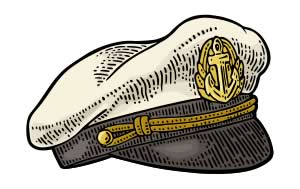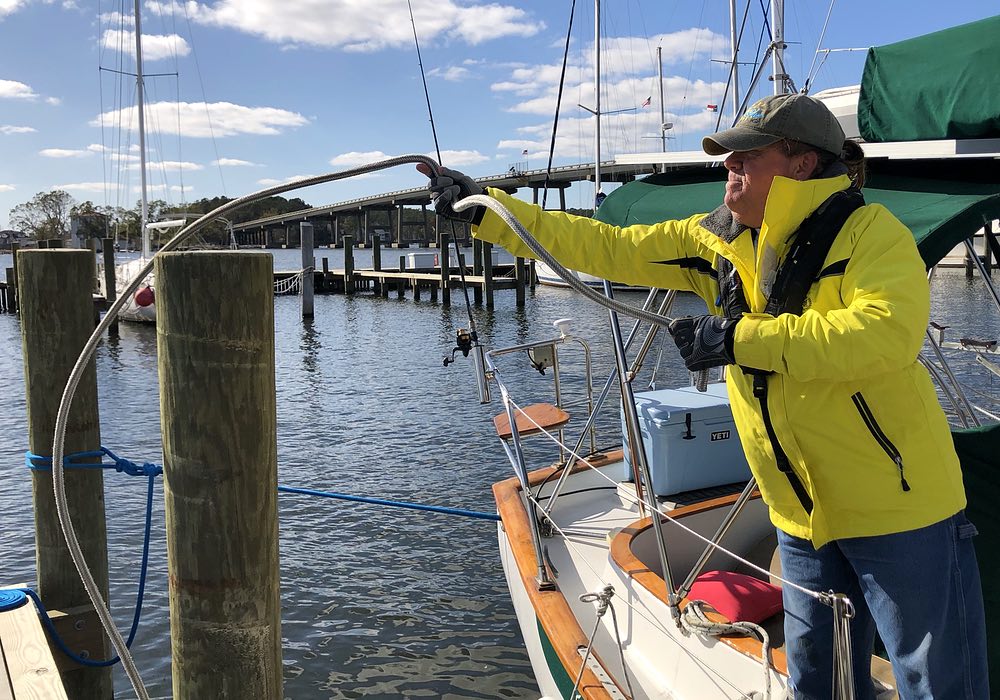It's Thursday April 25, 2024
News From The Village Updated Almost Daily

November 2019
“Spring lines cure a lot of evils”. When coaching docking, I say this often. I confess, the phrase has a loose sense of meaning. Better said, spring lines can save the day. A sail boater can arrive at a pier “way screwed up”. But, once a spring line aft is set, all is right with the world. Spring lines work best at a wharf slip. Although, sometimes I like this technique in a slip. Especially, if the winds are howling. Anyway, when arriving bow in alongside a wharf slip, I prefer the first line off the boat to be an aft spring line. The further aft off the boat, the better. The dock line should be angled back so it doesn’t allow the boat to drift forward.So, get an aft spring off the boat first. Yes, easier said than done.
How:
Put the eye end of the dock line on the boat cleat. Hang onto the bitter end of the dock line because the bitter end comes back aboard the boat. Stand forward on the boat near the shrouds. Then, using a long boat pole, Take a wrap around the first piling (or cleat) you can reach. The piling/cleat is wrapped by the spring.Take up tension (cleat hitch) to stop the boat from moving forward. Be careful. Don’t “bounce” the boat against the spring line. Bouncing the boat against a tensioned spring might slam the bow into the pier.
Now gently, idle forward (transmission/throttle) with the wheel turned outboard. The physics of the spring line aft, with the boat pushing forward, will snug the boat over against the pier. The wheel controls the alignment of the hull with the pier and the throttle controls rate of closure with the pier. If the boat is moving too quickly against, reduce the throttle; maybe neutral for a couple of “potatoes” then back into idle forward. If windy/current, more throttle/power may be required to snug the boat against the pier.
John Rahm sets the spring line.Once against:
Leave the boat in gear to keep it pinned. Make fast the remaining lines. Once you’re pleased with all the lines, neutral on the transmission. I’m convinced this is the best way onto a wharf slip; especially into a tight spot. When parking between two boats, angle into your intended spot. Get an aft spring off the boat (dockhands). Remember, the further aft the spring runs the better. Take up tension when your stern clears the boat behind. Once clear, it’s the same technique. Use the minimum throttle required, motoring forward against the aft spring, to get the boat sliding over towards the pier. Remember, the throttle controls rate of closure. The wheel controls alignment. Keep an eye on the boat forward. Some reverse and re-tensioning of the aft spring may be required to keep your boat centered in its spot. Magic! When given the choice, choose the downwind/down current side. Spring lines can also get you out of a tight spot.Reset a spring line aft by putting the eye end on the boat cleat. Take a wrap around an aft piling. Cleat hitch the bitter end (without any slack) back aboard the boat. Start the engine; transmission in idle forward to pin the boat against the pier. Remove all the lines except the tensioned spring line. Now you’re ready to go. Wheel towards the pier will swing the stern away from the pier. Wheel away from the pier will swing the bow away from the pier. Fenders, of course. If your propwalk is going to fight you, perhaps running a spring line forward would be a better choice.
Spring lines that run forward from the stern work just the opposite. Motoring aft against a spring line forward will swing the bow out. Good when you’re pinned against a wharf by wind. Fenders on the stern please!
In summary, a little practice with spring lines will give you another docking technique that transforms your arrival or departure into a very boring non-event. Practice makes perfect. I recommend some dedicated practice time at the town docks.
Fair winds,
Captain JohnCapt. John explains how to use slip lines in docking.
 Captain's Blog on TownDock.net is all about making your time on the water enjoyable. Captain John Rahm teaches sailing and boat handling at Third Wave Sailing. Captain's Blog on TownDock.net is all about making your time on the water enjoyable. Captain John Rahm teaches sailing and boat handling at Third Wave Sailing. |

